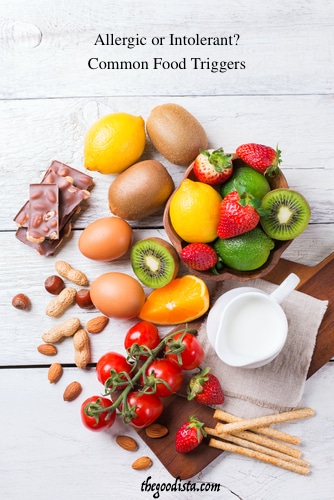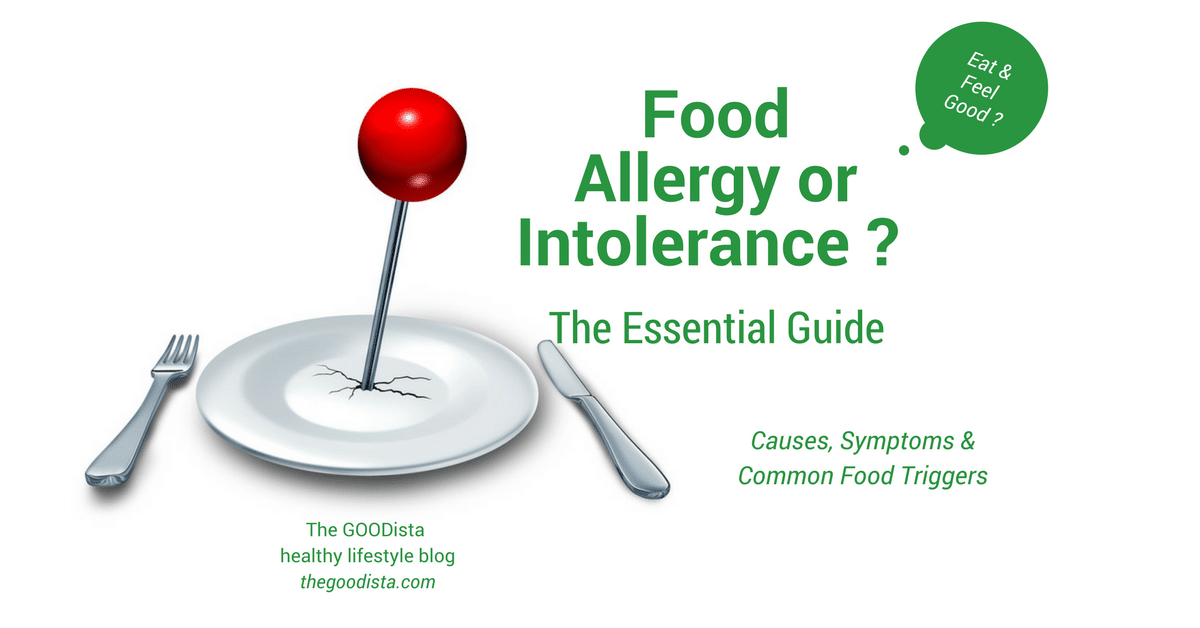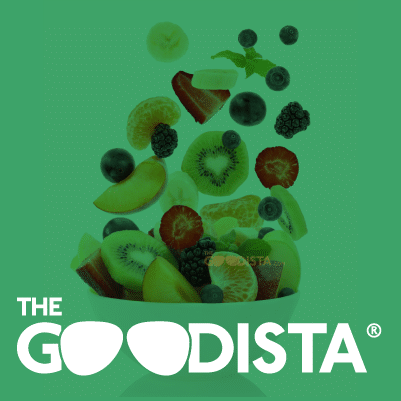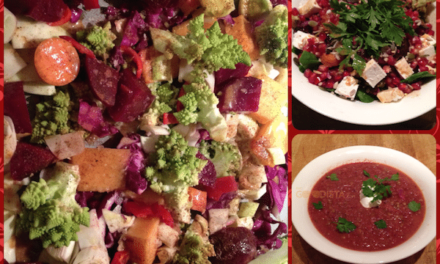Food allergy or intolerance are medical conditions – not fussiness, nor food preference. For someone who is neither allergic nor intolerant it can be hard to understand how difficult, frustrating and complex it can be. Imagine if you can’t trust what you eat! It is pure detective work to figure out what you can eat or not. And – to know if you are allergic or intolerant is another struggle. Here is your essential guide to food allergy and intolerance, common trigger foods with lots of resources, recommendations, and must-know information.
Welcome to a two-part series: In Part 1 you find the essential basics of what food allergy or intolerance is, and common food triggers. In Part 2 you get tips how to live with allergy and/or intolerance. Both posts are filled with resources, such as links to medical sites, recommended books and articles. Feel free to share, comment and review — and — of course, you’re welcome to join our mailing list.
Allergy or Intolerance: Must You Eat Your Food?
Food is supposed to be enjoyed, appreciated and you must eat up, right? If you say you don’t want to eat something — then surely you’re spoilt, fussy or simply rude! 
Education and public information have made progress. Yet – there is still a perception that allergy or intolerance is food preference, rather than a medical condition.
Food is supposed to be the fuel that we build a healthy body and mind on. Despite the increase in awareness many struggles to figure out if they have a food allergy or an intolerance. Parents see how their children suffer, but don’t always understand that food is the cause. Must you eat your food?
Food Allergy or Intolerance: Why It Matters
It has been revealing to research, read and try to make sense of how allergy or intolerance impact health and wellbeing. I thought I had a fair idea… I discovered how:
been revealing to research, read and try to make sense of how allergy or intolerance impact health and wellbeing. I thought I had a fair idea… I discovered how:
- Research shows how the impact of allergies and intolerances can be dramatic. Allergies can be fatal. This is why it is so important to find out if you’re allergic or intolerant.
- Children can be especially vulnerable when the root cause of their symptoms is not understood. The effect of allergies and/or intolerances can be labeled as learning difficulties or ADHD. Therefore – understanding how food can be the root cause makes a huge difference in child development, and later life.
Let’s get to grips with the basic essentials. What are the food allergy or intolerance symptoms and causes? Can you suffer from both, and what triggers it?
FOOD ALLERGY OR INTOLERANCE: Your Basic Guide
If you don’t have any allergies or intolerances, you are lucky. I am sure you know someone who does. Allergies and intolerances are on the rise. Knowing more about allergy and intolerance gives you prevention ability. You can eat healthy while avoiding common food triggers. And – your guests will be happy if you serve food they can eat, right?
Here below we give you the essential basics of shared symptoms, causes and what differentiates food allergy and intolerance.
ALLERGY AND INTOLERANCE BASICS
Allergy or intolerance will impact different parts of the human body systems. Figuring out what you can eat or not, and how a given food impacts you can be pure detective work. Here are the basic facts on how allergies and intolerances impact the human body systems and common food triggers. Click the links for more details and resources.
- Food allergies are different from intolerances: An allergy can be life-threatening. Food intolerance will not claim lives.
- Body system impact: Food allergy will trigger an abnormal reaction of the body’s immune system to a particular food. Food intolerance will impact the digestive system, as certain substances in food, will make you react directly or indirectly.
- Central nervous system: Because the scope of allergies or intolerances is so wide, they can affect almost every system in a child’s body, especially the central nervous system. Food allergies and intolerances may cause a child to have difficulty concentrating, become easily distracted and eventually, exhibit erratic learning patterns. Undetected allergy or intolerance lead many children to be labeled as having learning difficulties, ADHD etc. when food is the root cause.
- Legal Obligations: Scientific research has led to changes in the law in customers’ rights, food labeling, and restaurant food preparation. In 2004 the US Food Allergen Labelling and Consumer Protection Act (FALCPA) came into effect. In Europe, the regulation on the provision of food information to consumers, with the obligation to provide nutrition information, is applicable from December 2016 – which also applies to restaurants and takeaways.

ALLERGY OR INTOLERANCE? SYMPTOMS AND CAUSES
Food allergy versus food intolerance is still very confusing. Allergies affect the immune system, and intolerances the digestive system. What are the symptoms, and root causes?
Knowing the difference between an allergy or intolerance is essential because of the risks involved. Many grapple with understanding the root causes of our reactions to food. Parents often have to guess their way forward, before certainty is found.
The above basics are a start. How can you tell if you’re allergic or intolerant? Click the links for more details and resources.
Allergy AND Intolerance
- Food allergy and intolerance can both cause: Nausea, stomach pain, diarrhea, and vomiting. Intolerance can also mask an allergy – read below for more.
- Increased risk: The repetitive use of some common foods and the extensive use of chemicals, such as pesticides and additives, colorings, preservatives, and flavorings, has increased the risk to develop allergy or intolerance.
- Intolerance can mask Allergy, as the immune system often reduces the severity of symptoms, as a result of frequent use of various foods. It masks the allergy, thereby making it more difficult to identify. It can lead allergy or intolerance to remain undetected – with dire consequences, especially in children.
Food Allergy
- Food allergy: Signs and symptoms of a food allergic reaction can range from low-grade to life-threatening.
- Allergies usually come on suddenly and can be triggered by only a small amount of food. The reaction will be there every time you eat the food, and eating the food can literally kill you.
- An allergy happens when your immune system mistakes something in the food and attacks it. It affects the whole body, and not just the stomach. Allergy symptoms can include rashes, hives, itchy skin, shortness of breath, or chest pain.
- The most severe allergic reaction is anaphylaxis — a life-threatening whole-body allergic reaction. This allergic reaction can lead to swollen lips or mouth, breathing difficulty and sudden drop in blood pressure/unconsciousness -> Call for emergency help. (Source: WebMD)
Food Intolerance
- Food intolerance: While not life-threatening — can cause considerable discomfort and reactions.
- Food intolerance usually comes on gradually, and may only happen if you eat a lot of a certain food. Also – if you eat a certain food often you can develop an intolerance.
- Food intolerance happens when food irritates the stomach or your body can’t digest it. The symptoms include gas, cramps, bloating, heartburn, headaches, irritability and/or nervousness.
- People tend to self-diagnose or ignore food intolerance and use self-prescription drugs instead of looking at what they eat.
COMMON FOOD ALLERGIES AND INTOLERANCES
The confusion and detective work when figuring out what it is that disagrees with you is tough. Because of the cross-contamination in shop bought/processed foods, it is even more complicated. Let’s consider the most common food triggers.
Common Food Triggers
Certain foods trigger reactions and are called allergens:
- 90 % of all allergies come from the “Big 8”: Milk, Eggs, Peanuts, Soy, Wheat, Tree nuts, Finfish, and Shellfish.
- In Europe that list has been expanded in number to 14: Cereals containing gluten, Crustaceans, Molluscs, Eggs, Fish, Peanuts, Tree Nuts, Soybeans, Milk, Celery, Mustard, Sesame, Lupin and Sulphur dioxide.
- Almost any food can trigger an allergy though. Less common ones include: Corn, Gelatin, Meat (beef, chicken, mutton, and pork), Seeds (often sesame, sunflower, and poppy), Spices (such as caraway, coriander, garlic, and mustard)
ALLERGY OR INTOLERANCE OR BOTH?
Food intolerances are mainly from dairy, gluten and food additives. Did you know that a suspected intolerance can actually be an allergy? With the three most common so-called intolerances it is often the case.

- Dairy: The most common intolerance is lactose intolerance. This is when people cannot digest the sugar that is naturally found in milk and dairy.
- Additives: Many complain of feeling sick after eating fast foods or convenience foods. High levels of additives can cause strong bodily reactions. They are related to the digestive system, i.e. an intolerance. Reactions can come from for example Pizza meats, Chinese takeaway, and pre-packed food items.
- Gluten: Gluten intolerance comes from the body’s inability to process gluten. If you have celiac disease you have a gluten allergy. Eating gluten triggers this is a long-lasting digestive condition. While it does involve the immune system, it doesn’t cause life-threatening symptoms.
- Dairy: Be aware that some are allergic to casein – the protein found in milk and dairy, which can provoke much stronger reactions. Knowing whether you are intolerant or allergic to milk products is essential and requires extensive testing.
- Additives: Be aware that you can also have an allergy to sulfites, MSG or other food additives. Regretfully this is becoming increasingly common. Sulphites, in particular, can cause asthma attacks in some people.
- Gluten: Be aware of is that some symptoms of an allergy to wheat — stomach cramps, diarrhea and other gastrointestinal symptoms — overlap with those caused by an intolerance to gluten or by celiac disease. Hence, it’s crucial to get an accurate diagnosis.
ALLERGY OR INTOLERANCE: Food Is Fuel
 The research into this post showed how very complicated, and complex it is to differentiate between an allergy and an intolerance. It also showed me how precarious children are. The impact of undetected allergies and intolerance is dramatic as the root cause is the food that should fuel a healthy, developing body into a whole being!
The research into this post showed how very complicated, and complex it is to differentiate between an allergy and an intolerance. It also showed me how precarious children are. The impact of undetected allergies and intolerance is dramatic as the root cause is the food that should fuel a healthy, developing body into a whole being!
The best prevention to ill-health is knowledge and common sense. We have been told that you are what you eat, not what you avoid. You can eat healthily — and safely — if you suffer from an allergy or intolerance. You just need to plan, think and prepare in a different way.
These medical conditions are on the rise. You need to be your own body mechanic to survive in the jungle that food has become. Make sure to read Part 2 to get tips, recipes, and ideas how to survive in the food jungle — especially if you, or someone you care for, suffer from suspected allergy or intolerance.
We thank you for reading and hope you comment, share and review this post. Oh! And – you’re of course welcome to join our mailing list for updates, newsletter and more here below.
Recommended and Related:
- Food Allergies and Food Intolerance – WebMD
- Food Allergies and Intolerance – Harvard Health
- Food Allergies, Symptoms and Types – acaai.org
- Difference Food Allergy versus Intolerance – Mayo Clinic
- Food Intolerance: Causes, Symptoms and Diagnosis – Medical News Today
- Food Allergy, Intolerance and Learning Difficulties – Natural Health 365














This is very informative! It’s great to learn the difference between food allergies and food intolerance. In that way, we could better choose the appropriate medicine or treatment.
It really helped when you talked about how allergies and intolerances to food can be fatal, so it is important to learn about them early on. I can see how taking the time to understand yourself and how to prevent serious side effects can help you make sure you avoid permanent injuries. As I see it, taking the time to consult with a professional can help you understand how your body works and what you are allergic to can help you find the right medicine and avoid unnecessary pain.
Dear Marcus, Thanks for commenting! Indeed consulting with a Doctor is really important when figuring out what you are allergic to and what intolences you have. You can read more on thegoodista how to deal with food allergies and intolences in Part 2. Ciao, Anna
My little nephew has a few food intolerances and he really hates it. So, I liked that you talked about how there are medications on the rise that can help you manage your intolerances. That is a good thing to be aware of if you want to eat food that your body doesn’t agree with.
Hello Ivy, Thanks for commenting. While medication is on the rise to help someone cope with food allergies and intolerences – they do have side effects You may wish to read Part 2 in our series about Allergies or Intolerances? Tips How To Win In The Food Jungle. Ciao, Anna
very nice website and informative
Thanks for your comment, and welcome back to thegoodista.com anytime for healthy lifestyle information and articles. Ciao
What a essential guide to food intolerance and allergies! Thank you for such a well researched post! Simply a great tool. And also enlightening! With an intolerance due to food poisoning more than thirty years ago, I am well aware of the challenges involved and truly wish to thank you.
Thanks for your comment, and so glad that you found our Part 1 about Allergy and Intolerance useful. Look out for Part 2, where we give tips about how to survive in the ‘food jungle’.